25 OCTOBER – 04 NOVEMBER 2022
By Eduardo Ormaeche
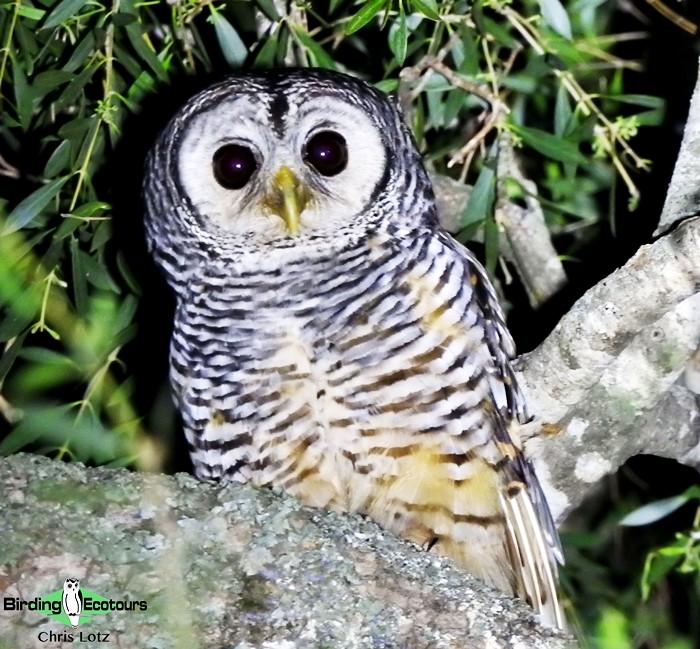
Chaco Owl, one of the many targets of our tour.
Overview
Paraguay, while often overlooked by travelers due to its remoteness, offers birders a richly unique wildlife experience. Recent improvements to infrastructure and transport in the country, a growing number of local birders, and newly created private nature reserves have made previously unexplored birding hotspots accessible. For these reasons, Paraguay has seen an increasing number of adventurous travelers and birders visiting this remote South American country.
Birding in Paraguay offers a unique opportunity to explore several habitats that can only be found in southern South America, including the Great Chaco, comprising transitional habitats like humid Chaco and seasonally flooded Chaco, as well as grassland areas which is a particular drawcard for avid bird listers. We also encounter expansive areas of Cerrado habitat, which is typical of this part of the continent. The Cerrado is an ancient relict of the far western Atlantic Forest of South America and comprises temperate grasslands. The rich diversity of habitats that Paraguay has to offer affords birders an increased chance of finding elusive birds that are often missed in neighboring countries. A birding tour to Paraguay provides unique opportunities to find especially tough birds such as Chaco Owl, Saffron-cowled Blackbird, Black-bodied and Robust Woodpeckers, Vinaceous-breasted Amazon, White-winged Nightjar, Cock-tailed Tyrant, and other iconic species of southern South America. In addition to avian diversity, the Great Chaco is one of the best places to see wildlife in South America which together with the Brazilian Pantanal, offers birders the chance to see and photograph a unique set of mammals including several of South America’s Big Five. A further enticing feature of Paraguay is the absence of large groups of other tourists adding to the feeling of a truly wild and remote adventure which will appeal to the more adventurous birder.
Despite my previous scouting trip a few years ago, this was the first official Birding Ecotours tour to Paraguay. It was a short tour which ran for 11 days, with nine full days of birding. We covered a significant distance from Asunción all the way to the Teniente Enciso National Park, which included exploring the Chaco and all its transitional habitats. We then returned to Asunción after visiting the Mbaracayú Reserve which added some Atlantic Forest species to our list. We succeeded in finding several species on our target list including some of the most iconic species of the continent. This was especially exciting for the birding beginners and those on the tour who were new to neotropical birding. We also had some great encounters with animals which added further diversity to the trip. We endured heat, long drives and early starts to ensure we maximized our chances of seeing our target birds. Although we had to drive long distances, we were impressed by the many great new roads in the country. Perhaps the biggest inconvenience was the early starts and late ends to the day, further compounded by the fact that in Paraguay, as well as in Argentina and Spain, it is customary for people to have late dinners. Interestingly, what some travelers considered dinner time aligned with the optimal period for observing nocturnal birds and wildlife in Paraguay.
During our nine days of birding, we managed to see some stunning birds including Chaco Owl, Black-capped Screech Owl, Greater Rhea, Southern Screamer, Red-legged and Black-legged Seriemas, Brushland Tinamou, Spotted Nothura, Rufous Nightjar, Cock-tailed Tyrant, Strange-tailed Tyrant, Scimitar-billed Woodcreeper, Olive-crowned Crescentchest, Stripe-backed Antbird, Robust Woodpecker, Ochre-collared Piculet, Blue Manakin, King Vulture, Jabiru, Rufous-capped Motmot, Spot-billed Toucanet, Toco Toucan, Pheasant Cuckoo, Plumbeous Ibis, Ringed Teal, Surucua Trogon and Buff-bellied Puffbird. Early morning and night drives resulted in great views of Giant Anteater, Pampas Fox, Crab-eating Raccoon, Southern Three-banded Armadillo and several Lowland Tapirs. Furthermore, we had glimpses of Ocelot and Geoffroy’s Cat and we found fresh Jaguar and Puma tracks all over the Teniente Enciso National Park.
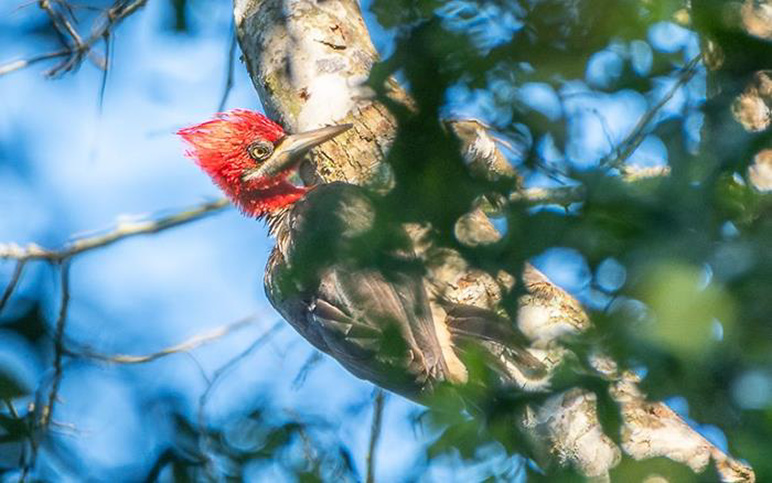
Robust Woodpecker is one of the rarest birds in South America (photo Oscar Rodriguez).
This is a trip I would highly recommend not only for adventurous birders and listers, but also for wildlife and nature lovers in general.
Detailed Report
Day 1, 25th October 2022. Arrival in Asunción and botanical garden birding
The group arrived in Asunción on different flights, with most of us arriving a couple of days earlier than our official start date. We decided to do some birding that afternoon in the Asunción Botanical Park where we recorded the first species of the trip. These included Narrow-billed Woodcreeper, Green-barred Woodpecker, Greenish and Large Elaenias, Plush-crested Jay, Red-crested Cardinal, Sayaca Tanager, Brown-crested Flycatcher, Monk and Yellow-chevroned Parakeets, Cobalt-rumped Parrotlet (split from Blue-winged Parrotlet) and our first Guira Cuckoo. We also saw some aquatic species including Rufescent Tiger Heron, Anhinga and Wattled Jacana.Interestingly,the name Sayaca (of the above tanager) comes from the Tupí Amerindian (Brazilian) name sayacu for a type of finch, while similarly the name Güira (of the above cuckoo) comes from the Guarani Paraguayan name güirá which means bird.
We later met in our comfortable hotel at the Bourbon Conmebol Convention Center. This was once the infamous Latin American headquarters of the FIFA football association that was involved in a case of wire fraud, racketeering and money laundering which involved the FBI back in 2015 and was big news worldwide especially in South America. Despite this, our accommodation was extremely comfortable and the views of the illuminated football fields adjacent to us were nice. After supper, we went to sleep and were well-rested for the next day’s intensive birding.
Day 2, 26th October 2022. Birding humid Chaco, transfer to Loma de Plata
Even though most of the roads in Paraguay have improved in recent years, we still needed 4×4 vehicles to drive through the Chaco. On this particular trip with only five participants, we had two 4×4 vehicles to provide each participant with their own window seat to view the Paraguayan countryside. Our first stop took us into the humid Chaco where we had many iconic birds from southern South America such as Greater Rhea and Southern Screamer. These were followed by Brazilian Teal, Wood Stork, Cocoi and Striated Herons and the attractive-looking Whistling Heron. We then added a few water- and wetland-associated species such as Snail Kite, Black-collared Hawk, Black-backed Water Tyrant, the stunning Scarlet-headed Blackbird, Giant Wood Rail, Limpkin, and lots of Wattled Jacanas.
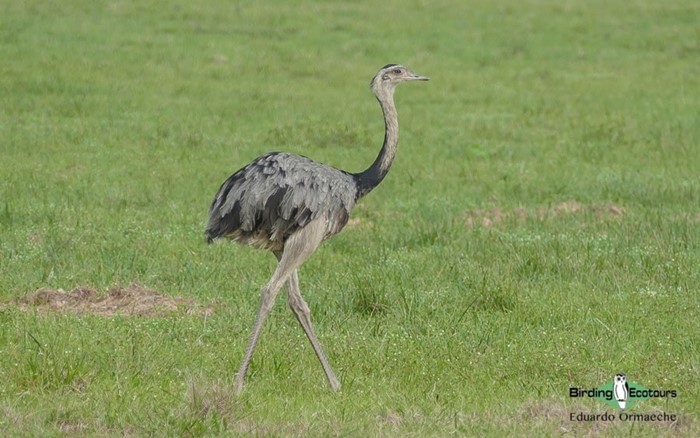
Greater Rhea, a classic southern South American species, seen on our Paraguay birding tour.
Exploring drier areas resulted in great views of Cream-backed Woodpecker, Campo Flicker, Nanday Parakeet, Red-billed Scythebill, Rufous Hornero, Greater Thornbird, Sooty-fronted Spinetail, White Monjita, Rufous Casiornis, Crowned Slaty Flycatcher, Rufous-browed Peppershrike, Plush-crested Jay, Solitary Cacique, Creamy-bellied Thrush, Masked Gnatcatcher, Chestnut-capped Blackbird, Ultramarine Grosbeak, Yellow-billed Cardinal, Red Pileated Finch, Pampa Finch, Double-collared and Rusty-collared Seedeaters.
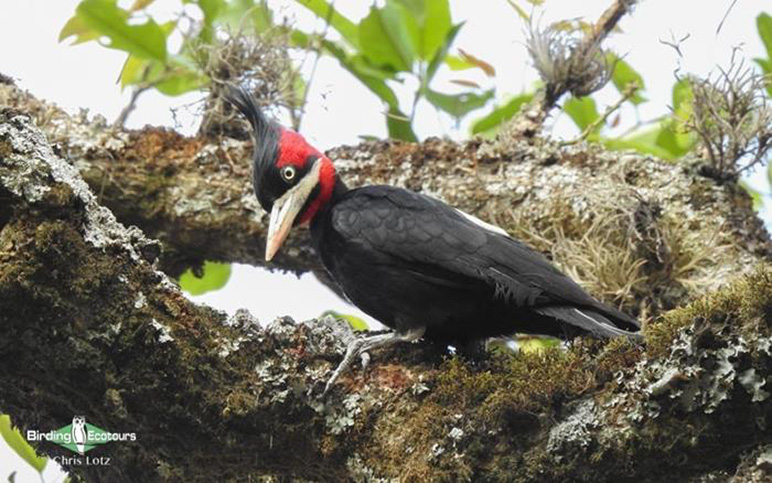
Our Paraguay birding tour was great for woodpeckers including this Cream-backed Woodpecker.
An exciting moment happened when we saw the elusive Pheasant Cuckoo fly in front of us. Even though our views were brief and might not have been ideal for photographers (as the bird remained concealed in the bush), we were still pleased to get scope views of this rare species.
Other birds seen before we left our first stop included Blue-crowned Parakeet (here of the nominate race acuticaudatus), Golden-green Woodpecker, Crested Caracara, Lesser Yellow-headed Vulture, the uncommon Tawny-headed Swallow, Picui Ground Dove, and Zone-tailed Hawk which is always a pleasure to see. The name Nanday comes from the Guarani Amerindian (Paraguayan) name ñendáy for the Black-hooded Conure, known today as Nanday Parakeet while the name Picui (of the above dove) comes from the Guarani name picúi for a small dove.
Near midday, we stopped at our stakeout to look for the sought-after Strange-tailed Tyrant. The day turned windy which was not a good sign. Oscar, our local guide and driver of one of the vehicles, took us to a place where we scanned the grasslands for the tyrant. It didn’t take long until we spotted a male, which although distant, provided great scope views. At the same spot, we added Plumbeous and Buff-necked Ibises, Maguari Stork, Cattle Tyrant, White-rumped Swallow and Tawny-bellied Seedeater.
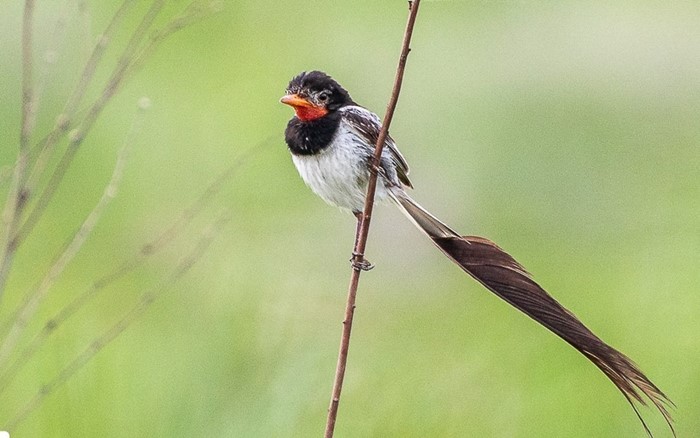
It was great to find the sought-after Strange-tailed Tyrant (photo Oscar Rodriguez).
We then continued our long drive to Loma de Plata and as the day was ending, we arrived at some freshwater ponds. This stop added Giant Wood Rail, Collared Plover, Pectoral, and Solitary Sandpipers, Greater and Lesser Yellowlegs, Greyish Baywing, Great Kiskadee, Great Pampa Finch, Plain Inezia, Black-backed Water Tyrant, our first Crested Hornero and included great views of White and Checkered Woodpeckers.
We arrived at Loma de Plata to check in at our hotel, ending the day on a positive note as we anticipated the exciting experiences that awaited us in the Chaco the following morning.
Day 3, 27th October 2022. Loma de Plata, Laguna Capitan to Iparoma Ranch
We started the day birding the surroundings of Loma de Plata on our way to Iparoma Ranch. Our first sightings of the day included species such as White-tailed Hawk, a classic Buteo from the savannas and Cerrado, White-browed Blackbird, Fork-tailed Flycatcher, Many-colored Chaco Finch, and Golden-billed Saltator. Laguna Capitan and its surroundings produced great birds including our first Spotted Nothura, here of the race chacoensis, which some authorities suggest may be a different species, Chaco Nothura. We also had Picazuro Pigeon, Glittering-bellied Emerald, Great Antshrike, White-barred Piculet, White-fronted Woodpecker, Brown Cacholote, Lark-like Brushrunner, Chaco Puffbird, Short-billed Canastero, Sooty-fronted Spinetail, Straneck’s Tyrannulet, Greater Wagtail-Tyrant, Cinereous Tyrant, Black-capped Warbling Finch, Variable Oriole, Chivi Vireo, Barred Antshrike, the incredible Scimitar-billed Woodcreeper, and one of the highlights of the trip was getting unreal, super, and ripper views of the elusive Stripe-backed Antbird. I have previously seen this species skulking in thick Chaco and Chiquitania forest in Bolivia and Paraguay, but never as close as on this occasion, giving us an amazing performance.
At a nearby lake we saw Coscoroba Swan, Brazilian Teal, Roseate Spoonbill, Southern Lapwing, Jabiru, and Large-billed Tern. In the surroundings of the lake we found Great Horned Owl at a daytime roost and also saw our first Ferruginous Pygmy Owl of the trip.
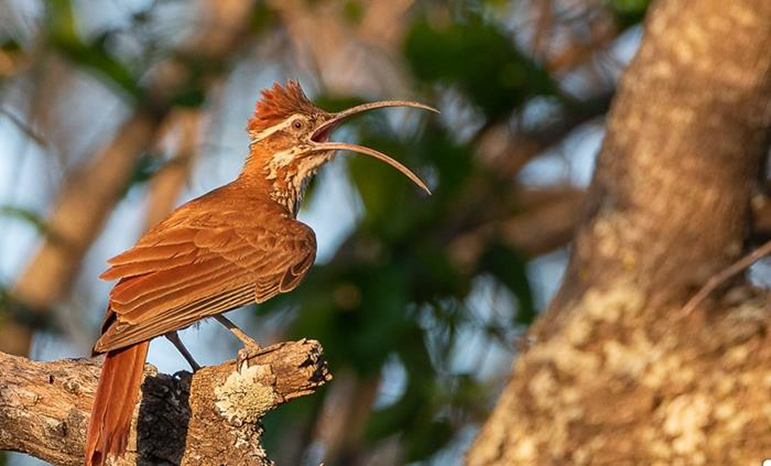
The amazing Scimitar-billed Woodcreeper (photo Oscar Rodriguez).
In the afternoon we birded near Boqueron where we had Chaco Chachalaca, Picui Ground Dove, Picazuro Pigeon, White-fronted, White, Golden-green and Green-barred Woodpeckers, Great Rufous Woodcreeper, Red-billed Scythebill, Crested Hornero, Lark-like Brushrunner, Little Thornbird, Stripe-crowned and Chotoy Spinetails, White-winged Becard, Pearly-vented Tody-Tyrant, Suiriri Flycatcher, White Monjita, Spectacled Tyrant, Many-colored Chaco Finch, Giant Wood Rail, White-tipped Dove and Sick’s Swift. Here we had our first encounter with the Chacoan Mara, a medium- to large-sized rodent, which together with the Patagonian Mara, is endemic to southern South America. These rabbit-like rodents are members of the Caviidae family which includes an assortment of rodents from the smaller guinea pigs to the large Capybara. Picazuro (of the abovementioned pigeon) comes from the Guarani name picazuró, which means sour pigeon, from the taste of its flesh after it has eaten certain fruits. Sick’s Swift is named after Helmut Sick (1910 – 1991), the German ornithologist, collector and author who visited Brazil.
We arrived at Iparoma Ranch before dusk where we managed to find the nocturnal Azara’s Night Monkey in the lodge vicinity. During our supper Oscar alerted us to the presence of a couple Chaco Owls – we were extremely happy to find this highly desirable owl species.After dinner at the end of a long day, only a couple of the participants decided to join Oscar and I on the night drive in the Iparoma Ranch vicinity. We drove for an hour and were amazed to find Crab-eating Raccoon, Lowland Tapir, and had glimpses of Ocelot. We also had views of the secretive Geoffroy’s Cat,proving that the haciendas in the Chaco is the best place in the world to see this small and secretive cat.
Day 4, 28th October 2022. Iparoma Ranch to Teniente Enciso National Park
Today we left Iparoma and birded in the general area which produced species we had previously seen such as Masked Gnatcatcher, Chaco Puffbird, White-barred Piculet, White and White-fronted Woodpeckers, Monk and Blue-crowned Parakeets, Crested Hornero, Swainson’s and Brown-crested Flycatchers, White-browed Blackbird, Screaming Cowbird, Chaco Chachalaca and Spotted Nothura.
We began the long journey to Mariscal Estigarribia, which is the closest town to Teniente Enciso National Park with suitable accommodation. Bearing in mind the long distances ahead, we decided to stop at a fuel station and to replenish our supplies. This freed us up to skip supper and to not have to return in a rush as this park offers good opportunities for some of our target species and mammals, including large cats. By doing this we took advantage of the best time for birds and wildlife which is in the afternoon.
We arrived at the park where we were greeted by the local park guard who escorted us along the trails of the thick and dense national park. It was still hot by 4 p.m. and although there was not much bird activity, we saw a few classic species such as Chaco Chachalaca, Picazuro Pigeon, Brown-crested Flycatcher, Brown Cacholote, and Monk Parakeet. We also added new species such as Laughing Falcon, Harris’s Hawk, American Kestrel, Turquoise-fronted Amazon and Sick’s Swift. We found fresh Puma tracks and some day-old Jaguar tracks. Amazingly, a Six-banded Armadillo appearedon the trail as it had beenscared by the group. Alarmed by the noise, it ran straight at me as I stood at the end of the line and came to a halt right at my feet.
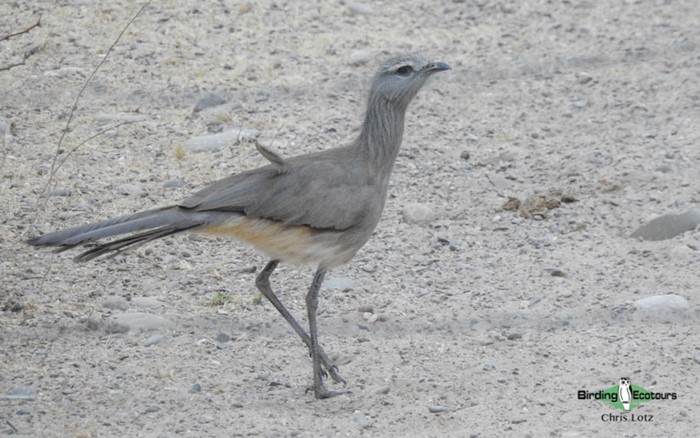
Black-legged Seriema at Teniente Enciso National Park.
Despite these great sightings we remained focused on our main target, the highly desirable Black-legged Seriema. According to the park guard, two of these birds were heard that very morning, between the entrance and the first few meters of the trail. We looked for ages until we found one of the two individuals from this morning and it was a great moment for everyone.
We waited until dusk, and while driving, we all got great views of American Barn Owl and Tropical Screech Owl. Once we left the park and drove along the dirt road, we found Little Nightjar. Mammal sightings included Crab-eating Fox, Lowland Tapir (two individuals) and the uncommon and seldom-seen Southern Three-banded Armadillo.
Day 5, 29th October 2022. Fortin Toledo and transfer to Neuland
We explored the Fortin Toledo area early in the morning where we tried for the elusive Crested Gallito.Unfortunately, no matter how hard we tried, the bird did not cooperate and would not show itself for the group, however the guides got glimpses of it through the thick, thorny bush. Despite this, we had other good encounters to make up for our dip such as Brushland Tinamou, Great Black and Roadside Hawks, Blue-tufted Starthroat, Crested Hornero, Lark-like Brushrunner, Southern Scrub Flycatcher, Large and Small-billed Elaenia, and Turquoise-fronted Amazon.
We then made a quick visit to the rehabilitation and breeding center of the endangered Chacoan Peccary. Here, we managed to see some animals in captivity, including Collared Peccary. Unfortunately, we never managed to encounter any of the rare Chacoan Peccaries in the wild. Interestingly, this species was discovered in 1930 and was believed to be extinct up until 1970 when it was found to exclusively inhabit the Chaco of Paraguay, extreme southeastern Bolivia and north-central Argentina.
We continued to try for Crested Gallito, and made our first attempt at finding the rare Black-bodied Woodpecker, but we unfortunately could not find any of these targets. We did however manage to find White-bellied Nothura, Dark-billed Cuckoo, Ferruginous Pygmy Owl, Streaked Flycatcher, Plush-crested Jay, and White-tipped Dove. It was quite hot and the birding was quiet, so we decided to continue with the drive, in order to give participants a break from the heat. We then visited Neuland Museum where we had the chance to see examples of Paraguayan fauna, and good didactic maps to explain the geography of the Chaco and Paraguay. This was helpful to better understand the distribution of the fauna in the country. We also had an introduction to the history of the Mennonites who had established themselves in Paraguay over a century ago. This turned out to be more interesting and emotional than we anticipated, with the Mennonite speaker doing a wonderful job at immersing us in the local history.
We returned to the hotel in Neuland to get ready for an afternoon of birding back in the woods. Although we had seen these species previously on the trip, exploring before dusk produced species such as Golden-billed Saltator, Narrow-billed Woodcreeper, White-fronted and Cream-backed Woodpeckers, Vermilion Flycatcher, Large Elaenia, Crowned Slaty Flycatcher, Plush-crested Jay, Red-crested Cardinal, and Black-chested Buzzard-Eagle and White-tailed Hawk and a Dark-billed Cuckoo. After this we visited some freshwater springs in the Chaco, where crepuscular wildlife often come to drink. As well as increasing our chances of great animal viewing, this also provided an opportunity for nightbirds, including Scissor-tailed Nightjar. We sat on the edge of the ponds and waited quietly. After a while, we had our first sighting of a couple of Pampas Foxes, which gave us brilliant views. The foxes came relatively close until they detected us, but gave us excellent views before they left. This species isonly found in southern South Americaand was a lifer foreveryone. At the same time we got the Scissor-tailed Nightjar (female) and we heard Common Potoo and Tropical Screech Owl. We could have waited for the male Scissor-tailed Nightjar, but we decided to leave a bit earlier. Watching wildlife and birds requires patience, especially when waiting in stakeouts, hides and ponds of water, and particularly in an environment like the Chaco.
Just before we left, we had an interesting and unusual experience when we spotted a Red-tailed Boa on the road.We stopped the car to move it away from the road to prevent it from being run over. This is especially important based on the high numbers of roadkill in Paraguay and because many locals do not like snakes. The snake was startled by our attempts to move it and crawled under our vehicle and into the engine, so we had to work together to remove it. As the removal looked like it might take a while, I decided to send people who could not wait with Chris to the hotel in one of the vehicles. Eventually we succeeded and returned the snake to the bush, back where it belonged. Once we had returned to the hotel, we toasted the boa’s rescue with a cold beer.
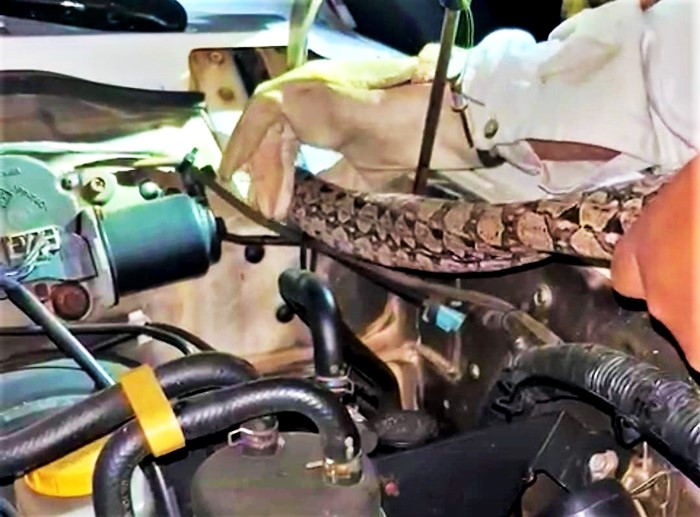
Oscar and Eduardo removing the Red-tailed Boa from the vehicle.
Day 6, 30th October 2022. Birding the Chaco
This morning we had an early start to be in the bush at first light. This rewarded us with an excellent view of a Giant Anteater, one of the Big Five of South America. After this sighting we started looking for the Black-bodied Woodpecker, one of the rarest birds in South America, and a major target for the trip. We looked for it at several strategic spots, but we didn’t get any response from the bird. Although we were in the right habitat, and searched in the right type of old trees, the bird did not respond. Only a week later, Oscar managed to find and photograph an adult in the same spot that we had tried, perhaps this later sighting could perhaps be explained by the nesting behavior of this particular pair.
The star of the day, and highlight for several participants, was the beautiful Olive-crowned Crescentchest which showed amazingly well for everybody. Other birds found this morning included species such as Plain Inezia, Chaco Earthcreeper, Fulvous-crowned Scrub Tyrant, (a recent split from Tawny-crowned Pygmy Tyrant), Crested Hornero, Many-colored Chaco Finch, Black-capped Warbling Finch, Narrow-billed and Great Rufous Woodcreeper, White-fronted, Checkered and Cream-backed Woodpeckers, Blue-crowned Parakeet, Turquoise-fronted Amazon, and some of the group managed to get glimpses of the elusive Crested Gallito.
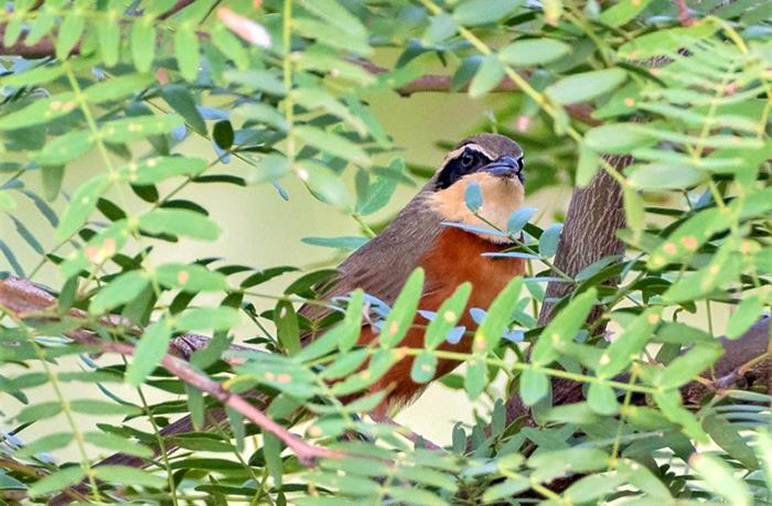
Olive-crowned Crescentchest, a highlight for several participants (photo Oscar Rodriguez).
This was our last morning in this amazing and unique, but poorly understood ecosystem. We left the Chaco with mixed feelings: gratitude for the experience, but also longing for the birds we had not seen, in particular, Black-bodied Woodpecker and Quebrancho Crested Tinamou. It was sad and shocking to see the extent of the habitat destruction in the Chaco, as a result of charcoal production and other factors, which makes the task of finding Chaco specials even trickier.
We started driving out of the Chaco towards Santa Rosa de Aguaray, and en route we located an ideal spot for the handsome Red-legged Seriema, which showed well for us. It was awesome being able to see both of the world’s two species of seriemas in a single trip – another bird family ticked off.
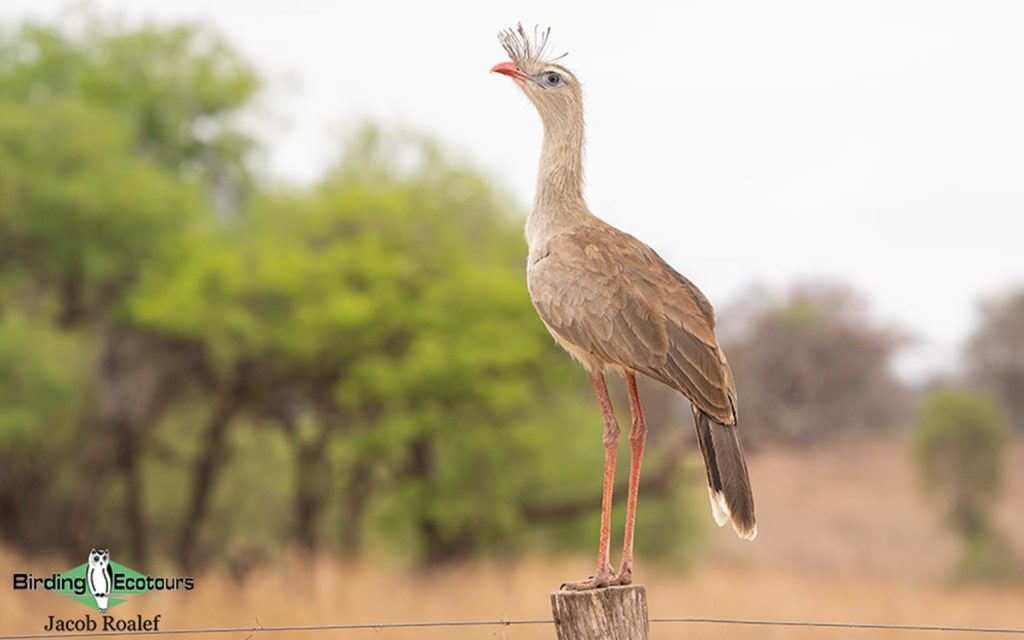
Red-legged Seriema was seen well on our trip.
Day 7, 31st October 2022. Transfer to Santa Rosa del Aguaray
Today we experienced one of the longest days of the trip as we drove from the Chaco towards Santa Rosa del Aguaray, the nearest town with access to Cerrado habitat. Along the drive, we made strategic stops for better photographic opportunities of birds which we had seen previously.
Day 8, 1st November 2022. Rio Verde Forest Reserve and transfer to the Mbaracayú Reserve
We left Santa Rosa del Aguaray and drove towards the Rio Verde Forest Reserve which contains some nice Cerrado habitat, and here we tried to see as many specials as possible. We soon found Burrowing Owl, White Woodpecker, Campo Flicker, Peach-fronted Parakeet, Yellow-bellied and Lesser Elaenias and an Aplomado Falcon. We continued driving deep into the Cerrado when I suddenly stopped the vehicle as I spotted a Common Potoo roosting which I thought could provide good photo opportunities. We didn’t waste much time and soon found Grassland Sparrow, Black-throated Saltator, Curl-crested Jay, Wedge-tailed Grass Finch, Blue-black Grassquit, and Rusty-collared Seedeater. The birding continued nicely until we finally got two Cerrado targets, White-rumped Tanager and Shrike-like Tanager (which is also known as White-banded Tanager).
We next had Savanna Hawk and our first Hook-billed Kite, withmuch excitement when we found the beautiful Cock-tailed Tyrant (male) which displayed nicely for us, as well as the other highly prized Tyranidae (New World flycatcher), the pretty Streamer-tailed Tyrant, with all our targets showing well for us here. However, soon the temperature started to heat up quickly and the birding activity slowed down, so we decided to head out and started our drive to the Mbaracayú Reserve near the Brazilian border. We arrived in the late afternoon with a whole new set of birds waiting for us.
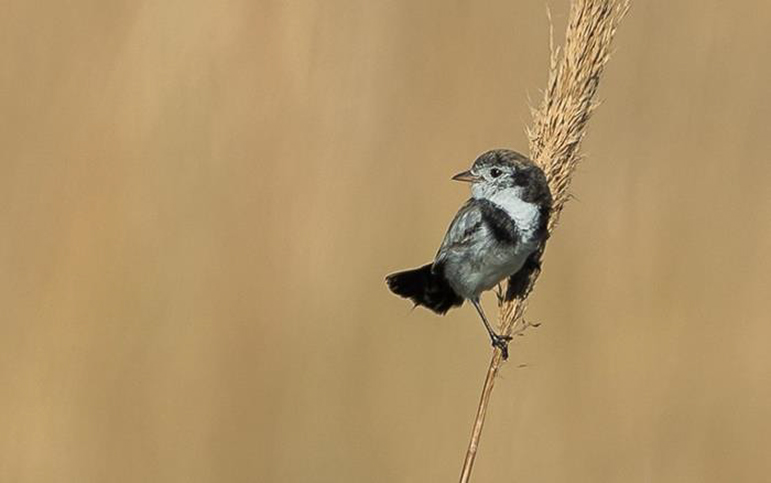
Cock-tailed Tyrant, a cute little flycatcher found in the Cerrado (photo Oscar Rodriguez).
Day 9, 2nd November 2022. Birding Mbaracayú Reserve
Today we had a full day to explore the impressive Mbaracayú Reserve. This 64,505-hectare reserve, protects two main ecosystems; Atlantic Forest and the Alto Paraná Atlantic Forest. These forests were originally inhabited by two ethnic groups, the Guaraní and the Aché (the latter of which has a population of fewer than 2,000 individuals). Some families inhabit the borders of the reserve and are a real anthropological treasure, providing endless cultural knowledge and a deep understanding of the forest. We didn’t have much time and we started birding the trails and the lodge’s clearings, finding species such as Scaled Pigeon, Blue Ground Dove, Surucua Trogon, Rufous-capped Motmot, Blue Manakin, Scaly-headed Parrot, Maroon-bellied Parakeet, Spot-backed Antshrike, Plain Antvireo, White-shouldered Fire-eye, Crested Becard, and Southern Antpipit. Grey-hooded Flycatcher did not respond for us, but after some extra work and with a different strategy, Chris and I managed to see this forest skulker. In addition, we saw Sibilant Sirystes, Squirrel Cuckoo, Boat-billed, Piratic, Variegated and Social Flycatchers, Purple-throated and Violaceous Euphonias, Thrush-like Wren, Pale-breasted Thrush, Blue-naped Chlorophonia, Plush-crested Jay, Red-rumped Cacique, Magpie Tanager, and Chestnut-vented Conebill.
In the afternoon we heard the bad news that the recent rains in the reserve had completely washed away the wooden bridge that connects the main reserve road with the Cerrado habitat behind the reserve. This unfortunately meant that our chances for the White-winged Nightjar, one of our main targets and a Vulnerable species, were also washed away. Although this was the main disappointment of the trip, there was nothing we could do about it, as accessing the site was literally impossible.
Despite the disappointment, we birded the reserve finding White-throated Woodcreeper, Buff-fronted Foliage-gleaner, Band-tailed Manakin, Black-crowned and Masked Tityra, Chestnut-crowned Becard, Grey-headed, Plumbeous, and Swallow-tailed Kites and Black-and-white Hawk-Eagle. The elusive Spotted Wood Quail was heard distantly.
After dark we tried for some night birds and were rewarded with incredible views of Rufous Nightjar, Pauraque, Short-tailed Nighthawk, American Barn Owl and Black-capped Screech Owl.
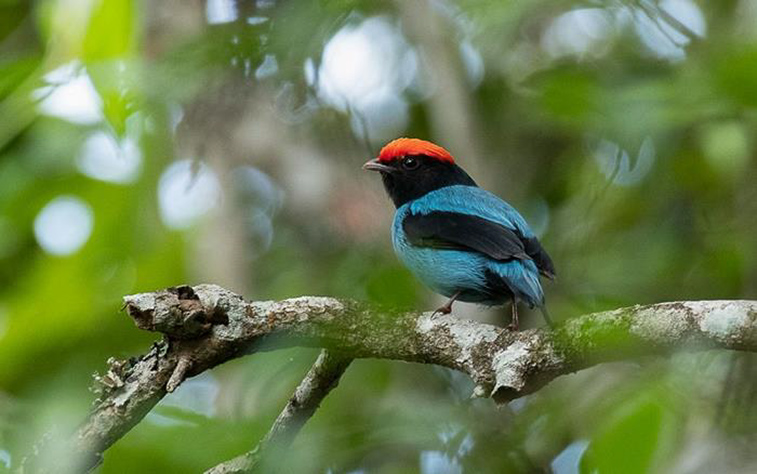
Blue Manakin is always a pleasure to see in the Atlantic forest (photo Ricardo Boschetti).
Day 10, 3rd November 2022. Mbaracayú, Arroyos y Esteros and transfer to Asunción
Early in the morning we started birding the lodge clearing finding Surucua Trogon, Spot-billed Toucanet, Ochre-collared Piculet, Turquoise-fronted Amazon, Glittering-bellied Emerald, Toco Toucan, King Vulture, Chopi Blackbird, Buff-bellied Puffbird and then total madness hit when Chris spotted the highly desirable Robust Woodpecker. It was great finding all these bird species in a single day and especially in just one morning. The only two species that evaded us here were Helmeted Woodpecker and White Bellbird. The name Surucua Trogon (Trogon surrucura) comes from the Guaraní name surucúa which refers to a trogon or similarly sized bird.
We then started the long drive back towards Asunción. We sadly arrived late at the Arroyos y Esteros Reserve outside Asunción and even though it was possible to stay a little longer, some participants were keen to return to the hotel, so we only spent a short time birding these wetlands. Although there was not enough time for the Ibera Seedeater, which we were hoping for, we instead got views of Southern Screamer, White-faced Ibis, Greater Ani, Maguari Stork, Snail Kite, Yellow-chinned Spinetail, Black-capped Donacobius, Yellow-rumped Marshbird, Brown-chested Martin, Fork-tailed Flycatcher, Rusty-collared Seedeater, Amazon Kingfisher, Striped Cuckoo, and Brazilian Teal among the other usual suspects.
We then entered Asunción and after dealing with the traffic, we arrived at our hotel. It was great to be back, have our last supper as a group, work on the checklist and get some well-deserved rest. We then said goodbye to some of the participants that were leaving early the following morning, with most of the group only leaving after breakfast.
Day 11, 4th November 2022. Transfer to the airport and departure
I spent most of the day in Asunción ensuring everyone was picked up at the airport and transferred to the hotel to catch their connecting international flights home. The trip was an amazing experience indeed. I really enjoyed Paraguay and it would be a pleasure to guide there again soon. Despite some long drives and the lack of home comforts, the facilities are reasonable to allow us to enjoy the real bush of South America. The Chaco is truly a place where anything is possible, especially at dawn and dusk, adding to the magic of Paraguay as a unique birding destination.
Bird List – Following IOC (13.1)
| Common Name | Scientific Name |
| Rheas (Rheidae) | |
| Greater Rhea | Rhea americana |
| Tinamous (Tinamidae) | |
| Brushland Tinamou | Nothoprocta cinerascens |
| White-bellied Nothura | Nothura boraquira |
| Spotted Nothura | Nothura maculosa |
| Screamers (Anhimidae) | |
| Southern Screamer | Chauna torquata |
| Ducks, Geese, Swans (Anatidae) | |
| Black-bellied Whistling Duck | Dendrocygna autumnalis |
| Coscoroba Swan | Coscoroba coscoroba |
| Brazilian Teal | Amazonetta brasiliensis |
| Ringed Teal | Callonetta leucophrys |
| Chachalacas, Curassows, Guans (Cracidae) | |
| Chaco Chachalaca | Ortalis canicollis |
| Nightjars (Caprimulgidae) | |
| Short-tailed Nighthawk | Lurocalis semitorquatus |
| Pauraque | Nyctidromus albicollis |
| Little Nightjar | Setopagis parvula |
| Scissor-tailed Nightjar | Hydropsalis torquata |
| Rufous Nightjar | Antrostomus rufus |
| Potoos (Nyctibiidae) | |
| Common Potoo | Nyctibius griseus |
| Swifts (Apodidae) | |
| Grey-rumped Swift | Chaetura cinereiventris |
| Sick’s Swift | Chaetura meridionalis |
| Hummingbirds (Trochilidae) | |
| Blue-tufted Starthroat | Heliomaster furcifer |
| Glittering-bellied Emerald | Chlorostilbon lucidus |
| Cuckoos (Cuculidae) | |
| Guira Cuckoo | Guira guira |
| Greater Ani | Crotophaga major |
| Smooth-billed Ani | Crotophaga ani |
| Striped Cuckoo | Tapera naevia |
| Pheasant Cuckoo | Dromococcyx phasianellus |
| Squirrel Cuckoo | Piaya cayana |
| Dark-billed Cuckoo | Coccyzus melacoryphus |
| Pigeons, Doves (Columbidae) | |
| Scaled Pigeon | Patagioenas speciosa |
| Picazuro Pigeon | Patagioenas picazuro |
| Ruddy Ground Dove | Columbina talpacoti |
| Picui Ground Dove | Columbina picui |
| Blue Ground Dove | Claravis pretiosa |
| White-tipped Dove | Leptotila verreauxi |
| Eared Dove | Zenaida auriculata |
| Rails, Crakes & Coots (Rallidae) | |
| Giant Wood Rail | Aramides ypecaha |
| Limpkin (Aramidae) | |
| Limpkin | Aramus guarauna |
| Stilts, Avocets (Recurvirostridae) | |
| White-backed Stilt | Himantopus melanurus |
| Plovers (Charadriidae) | |
| Southern Lapwing | Vanellus chilensis |
| Collared Plover | Charadrius collaris |
| Jacanas (Jacanidae) | |
| Wattled Jacana | Jacana jacana |
| Sandpipers, Snipes (Scolopacidae) | |
| Buff-breasted Sandpiper | Calidris subruficollis |
| Pectoral Sandpiper | Calidris melanotos |
| Spotted Sandpiper | Actitis macularius |
| Solitary Sandpiper | Tringa solitaria |
| Lesser Yellowlegs | Tringa flavipes |
| Greater Yellowlegs | Tringa melanoleuca |
| Gulls, Terns, Skimmers (Laridae) | |
| Large-billed Tern | Phaetusa simplex |
| Storks (Ciconiidae) | |
| Wood Stork | Mycteria americana |
| Maguari Stork | Ciconia maguari |
| Jabiru | Jabiru mycteria |
| Anhingas, Darters (Anhingidae) | |
| Anhinga | Anhinga anhinga |
| Cormorants, Shags (Phalacrocoracidae) | |
| Neotropic Cormorant | Nannopterum brasilianum |
| Ibises, Spoonbills (Threskiornithidae) | |
| Plumbeous Ibis | Theristicus caerulescens |
| Buff-necked Ibis | Theristicus caudatus |
| Bare-faced Ibis | Phimosus infuscatus |
| White-faced Ibis | Plegadis chihi |
| Roseate Spoonbill | Platalea ajaja |
| Herons, Bitterns (Ardeidae) | |
| Rufescent Tiger Heron | Tigrisoma lineatum |
| Striated Heron | Butorides striata |
| Western Cattle Egret | Bubulcus ibis |
| Cocoi Heron | Ardea cocoi |
| Great Egret | Ardea alba |
| Whistling Heron | Syrigma sibilatrix |
| New World Vultures (Cathartidae) | |
| King Vulture | Sarcoramphus papa |
| Black Vulture | Coragyps atratus |
| Turkey Vulture | Cathartes aura |
| Lesser Yellow-headed Vulture | Cathartes burrovianus |
| Kites, Hawks, Eagles (Accipitridae) | |
| Grey-headed Kite | Leptodon cayanensis |
| Hook-billed Kite | Chondrohierax uncinatus |
| Swallow-tailed Kite | Elanoides forficatus |
| Black-and-white Hawk-Eagle | Spizaetus melanoleucus |
| Long-winged Harrier | Circus buffoni |
| Plumbeous Kite | Ictinia plumbea |
| Black-collared Hawk | Busarellus nigricollis |
| Snail Kite | Rostrhamus sociabilis |
| Savanna Hawk | Buteogallus meridionalis |
| Great Black Hawk | Buteogallus urubitinga |
| Roadside Hawk | Rupornis magnirostris |
| Harris’s Hawk | Parabuteo unicinctus |
| White-tailed Hawk | Geranoaetus albicaudatus |
| Black-chested Buzzard-Eagle | Geranoaetus melanoleucus |
| Zone-tailed Hawk | Buteo albonotatus |
| Barn Owls (Tytonidae) | |
| American Barn Owl | Tyto furcata |
| Owls (Strigidae) | |
| Burrowing Owl | Athene cunicularia |
| Ferruginous Pygmy Owl | Glaucidium brasilianum |
| Great Horned Owl | Bubo virginianus |
| Tropical Screech Owl | Megascops choliba |
| Black-capped Screech Owl | Megascops atricapilla |
| Chaco Owl | Strix chacoensis |
| Trogons (Trogonidae) | |
| Surucua Trogon | Trogon surrucura |
| Kingfishers (Alcedinidae) | |
| Amazon Kingfisher | Chloroceryle amazona |
| Motmots (Momotidae) | |
| Rufous-capped Motmot | Baryphthengus ruficapillus |
| Puffbirds (Bucconidae) | |
| Buff-bellied Puffbird | Notharchus swainsoni |
| Caatinga Puffbird | Nystalus maculatus |
| Toucans (Ramphastidae) | |
| Spot-billed Toucanet | Selenidera maculirostris |
| Toco Toucan | Ramphastos toco |
| Woodpeckers (Picidae) | |
| White-barred Piculet | Picumnus cirratus |
| Ochre-collared Piculet | Picumnus temminckii |
| White Woodpecker | Melanerpes candidus |
| White-fronted Woodpecker | Melanerpes cactorum |
| Checkered Woodpecker | Veniliornis mixtus |
| Golden-green Woodpecker | Piculus chrysochloros |
| Green-barred Woodpecker | Colaptes melanochloros |
| Campo Flicker | Colaptes campestris |
| Robust Woodpecker | Campephilus robustus |
| Cream-backed Woodpecker | Campephilus leucopogon |
| Seriemas (Cariamidae) | |
| Red-legged Seriema | Cariama cristata |
| Black-legged Seriema | Chunga burmeisteri |
| Caracaras, Falcons (Falconidae) | |
| Crested Caracara | Caracara plancus |
| Yellow-headed Caracara | Milvago chimachima |
| Laughing Falcon | Herpetotheres cachinnans |
| American Kestrel | Falco sparverius |
| Aplomado Falcon | Falco femoralis |
| African & New World Parrots (Psittacidae) | |
| Monk Parakeet | Myiopsitta monachus |
| Yellow-chevroned Parakeet | Brotogeris chiriri |
| Scaly-headed Parrot | Pionus maximiliani |
| Turquoise-fronted Amazon | Amazona aestiva |
| Cobalt-rumped Parrotlet | Forpus xanthopterygius |
| Maroon-bellied Parakeet | Pyrrhura frontalis |
| Peach-fronted Parakeet | Eupsittula aurea |
| Nanday Parakeet | Aratinga nenday |
| Blue-crowned Parakeet | Thectocercus acuticaudatus |
| White-eyed Parakeet | Psittacara leucophthalmus |
| Ovenbirds (Furnariidae) | |
| White-throated Woodcreeper | Xiphocolaptes albicollis |
| Great Rufous Woodcreeper | Xiphocolaptes major |
| Red-billed Scythebill | Campylorhamphus trochilirostris |
| Scimitar-billed Woodcreeper | Drymornis bridgesii |
| Narrow-billed Woodcreeper | Lepidocolaptes angustirostris |
| Chaco Earthcreeper | Tarphonomus certhioides |
| Rufous Hornero | Furnarius rufus |
| Crested Hornero | Furnarius cristatus |
| Buff-fronted Foliage-gleaner | Dendroma rufa |
| Little Thornbird | Phacellodomus sibilatrix |
| Greater Thornbird | Phacellodomus ruber |
| Lark-like Brushrunner | Coryphistera alaudina |
| Short-billed Canastero | Asthenes baeri |
| Stripe-crowned Spinetail | Cranioleuca pyrrhophia |
| Brown Cacholote | Pseudoseisura lophotes |
| Yellow-chinned Spinetail | Certhiaxis cinnamomeus |
| Chotoy Spinetail | Schoeniophylax phryganophilus |
| Sooty-fronted Spinetail | Synallaxis frontalis |
| Antbirds (Thamnophilidae) | |
| Stripe-backed Antbird | Myrmorchilus strigilatus |
| Plain Antvireo | Dysithamnus mentalis |
| Barred Antshrike | Thamnophilus doliatus |
| Great Antshrike | Taraba major |
| Spot-backed Antshrike | Hypoedaleus guttatus |
| White-shouldered Fire-eye | Pyriglena leucoptera |
| Tapaculos (Rhinocryptidae) | |
| Crested Gallito | Rhinocrypta lanceolata |
| Crescentchests (Melanopareiidae) | |
| Olive-crowned Crescentchest | Melanopareia maximiliani |
| Tyrant Flycatchers, Calyptura (Tyrannidae) | |
| Grey Elaenia | Myiopagis caniceps |
| Greenish Elaenia | Myiopagis viridicata |
| Yellow-bellied Elaenia | Elaenia flavogaster |
| Large Elaenia | Elaenia spectabilis |
| Small-billed Elaenia | Elaenia parvirostris |
| Lesser Elaenia | Elaenia chiriquensis |
| Southern Beardless Tyrannulet | Camptostoma obsoletum |
| Suiriri Flycatcher | Suiriri suiriri |
| White-crested Tyrannulet | Serpophaga subcristata |
| Straneck’s Tyrannulet | Serpophaga griseicapilla |
| Southern Antpipit | Corythopis delalandi |
| Fulvous-crowned Scrub Tyrant | Euscarthmus meloryphus |
| Greater Wagtail-Tyrant | Stigmatura budytoides |
| Grey-hooded Flycatcher | Mionectes rufiventris |
| Southern Scrub Flycatcher | Sublegatus modestus |
| Plain Inezia | Inezia inornata |
| Pearly-vented Tody-Tyrant | Hemitriccus margaritaceiventer |
| Vermilion Flycatcher | Pyrocephalus obscurus |
| Spectacled Tyrant | Hymenops perspicillatus |
| Cinereous Tyrant | Knipolegus striaticeps |
| White Monjita | Xolmis irupero |
| Grey Monjita | Nengetus cinereus |
| Streamer-tailed Tyrant | Gubernetes yetapa |
| Black-backed Water Tyrant | Fluvicola albiventer |
| Cock-tailed Tyrant – VU | Alectrurus tricolor |
| Strange-tailed Tyrant – VU | Alectrurus risora |
| Cattle Tyrant | Machetornis rixosa |
| Piratic Flycatcher | Legatus leucophaius |
| Social Flycatcher | Myiozetetes similis |
| Great Kiskadee | Pitangus sulphuratus |
| Streaked Flycatcher | Myiodynastes maculatus |
| Boat-billed Flycatcher | Megarynchus pitangua |
| Variegated Flycatcher | Empidonomus varius |
| Crowned Slaty Flycatcher | Griseotyrannus aurantioatrocristatus |
| Tropical Kingbird | Tyrannus melancholicus |
| Fork-tailed Flycatcher | Tyrannus savana |
| Sibilant Sirystes | Sirystes sibilator |
| Rufous Casiornis | Casiornis rufus |
| Swainson’s Flycatcher | Myiarchus swainsoni |
| Brown-crested Flycatcher | Myiarchus tyrannulus |
| Manakins (Pipridae) | |
| Blue Manakin | Chiroxiphia caudata |
| White-bearded Manakin | Manacus manacus |
| Band-tailed Manakin | Pipra fasciicauda |
| Tityras, Becards, Sharpbill (Tityridae) | |
| Black-crowned Tityra | Tityra inquisitor |
| Masked Tityra | Tityra semifasciata |
| Chestnut-crowned Becard | Pachyramphus castaneus |
| Crested Becard | Pachyramphus validus |
| Vireos, Greenlets, (Vireonidae) | |
| Rufous-browed Peppershrike | Cyclarhis gujanensis |
| Chivi Vireo | Vireo chivi |
| Crows, Jays (Corvidae) | |
| Purplish Jay | Cyanocorax cyanomelas |
| Curl-crested Jay | Cyanocorax cristatellus |
| Plush-crested Jay | Cyanocorax chrysops |
| Swallows, Martins (Hirundinidae) | |
| Sand Martin | Riparia riparia |
| White-rumped Swallow | Tachycineta leucorrhoa |
| Tawny-headed Swallow | Alopochelidon fucata |
| Brown-chested Martin | Progne tapera |
| Grey-breasted Martin | Progne chalybea |
| Black-capped Donacobius (Donacobiidae) | |
| Black-capped Donacobius | Donacobius atricapilla |
| Wrens (Troglodytidae) | |
| Thrush-like Wren | Campylorhynchus turdinus |
| House Wren | Troglodytes aedon |
| Gnatcatchers (Polioptilidae) | |
| Masked Gnatcatcher | Polioptila dumicola |
| Mockingbirds, Thrashers (Mimidae) | |
| Chalk-browed Mockingbird | Mimus saturninus |
| Thrushes (Turdidae) | |
| Creamy-bellied Thrush | Turdus amaurochalinus |
| Pale-breasted Thrush | Turdus leucomelas |
| Rufous-bellied Thrush | Turdus rufiventris |
| Finches, Euphonias (Fringillidae) | |
| Hooded Siskin | Spinus magellanicus |
| Blue-naped Chlorophonia | Chlorophonia cyanea |
| Purple-throated Euphonia | Euphonia chlorotica |
| Violaceous Euphonia | Euphonia violacea |
| New World Sparrows (Passerellidae) | |
| Grassland Sparrow | Ammodramus humeralis |
| Oropendolas, Orioles, Blackbirds (Icteridae) | |
| White-browed Blackbird | Leistes superciliaris |
| Solitary Cacique | Cacicus solitarius |
| Red-rumped Cacique | Cacicus haemorrhous |
| Variable Oriole | Icterus pyrrhopterus |
| Screaming Cowbird | Molothrus rufoaxillaris |
| Shiny Cowbird | Molothrus bonariensis |
| Scarlet-headed Blackbird | Amblyramphus holosericeus |
| Chopi Blackbird | Gnorimopsar chopi |
| Greyish Baywing | Agelaioides badius |
| Chestnut-capped Blackbird | Chrysomus ruficapillus |
| Yellow-rumped Marshbird | Pseudoleistes guirahuro |
| Cardinals & Allies (Cardinalidae) | |
| Ultramarine Grosbeak | Cyanoloxia brissonii |
| Tanagers & Allies (Thraupidae) | |
| Pampa Finch | Embernagra platensis |
| Wedge-tailed Grass Finch | Emberizoides herbicola |
| Many-colored Chaco Finch | Saltatricula multicolor |
| Black-throated Saltator | Saltatricula atricollis |
| Bluish-grey Saltator | Saltator coerulescens |
| Golden-billed Saltator | Saltator aurantiirostris |
| Blue-black Grassquit | Volatinia jacarina |
| Red Pileated Finch | Coryphospingus cucullatus |
| Double-collared Seedeater | Sporophila caerulescens |
| Chestnut-bellied Seed Finch | Sporophila angolensis |
| Rusty-collared Seedeater | Sporophila collaris |
| Tawny-bellied Seedeater | Sporophila hypoxantha |
| White-rumped Tanager | Cypsnagra hirundinacea |
| Black-capped Warbling Finch | Microspingus melanoleucus |
| Chestnut-vented Conebill | Conirostrum speciosum |
| Saffron Finch | Sicalis flaveola |
| Shrike-like Tanager | Neothraupis fasciata |
| Magpie Tanager | Cissopis leverianus |
| Red-crested Cardinal | Paroaria coronata |
| Yellow-billed Cardinal | Paroaria capitata |
| Sayaca Tanager | Thraupis sayaca |
| Burnished-buff Tanager | Stilpnia cayana |
| Total species: | 253 |
Mammal List
| Common name | Scientific name |
| Guinea pigs and cavies (Caviidae) | |
| Chacoan Mara | Pediolagus salinicola |
| Brazilian Guinea Pig | Cavia aperea |
| Armadillos (Chlamyphoridae) | |
| Six-banded Armadillo | Euphractus sexcinctus |
| Southern Three-banded Armadillo | Tolypeutes matacus |
| Anteaters (Myrmecophagidae) | |
| Giant Anteater | Myrmecophaga tridactyla |
| Raccoons and allies (Procyonidae) | |
| Crab-eating Raccoon | Procyon cancrivorus |
| Canids (Canidae) | |
| Crab-eating Fox | Cerdocyon thous |
| Pampas Fox | Lycalopex gymnocercus |
| Cats (Felidae) | |
| Ocelot | Leopardus pardalis |
| Geoffroy’s Cat | Leopardus geoffroyi |
| Tapirs (Tapiridae) | |
| Lowland Tapir | Tapirus terrestris |
| Deers (Cervidae) | |
| Brown Brocket | Mazama gouazoubira |
| Night Monkeys (Aotidae) | |
| Azara’s Night Monkey | Aotus azarae |
| Total seen | 13 |
Reptile List
| Common name | Scientific name |
| Whiptails (Teiidae) | |
| Black-and-white Tegu | Salvator merianae |
| Red Tegu | Salvator rufescens |
| Alligators and caimans (Alligatoridae) | |
| Yacaré | Caiman yacare |
| Boas (Boidae) | |
| Red-tailed Boa | Boa constrictor |
| Skinks (Scincidae) | |
| Cope’s Mabuya (Chaco Skink) | Notomabuya frenata |
| Total seen | 5 |
This is a sample trip report. Please email us ([email protected]) for more trip reports from this destination.
